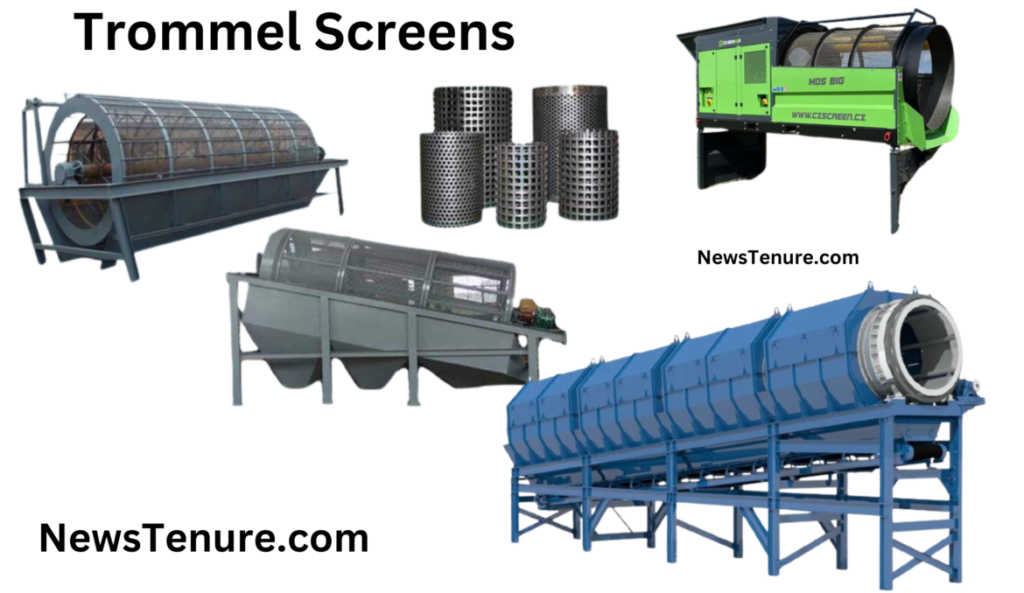Introduction
As the world grapples with mounting environmental challenges and the need for sustainable waste management practices becomes increasingly critical, innovative technologies like trommel screens are emerging as valuable tools in achieving more efficient and eco-friendly waste processing.
Trommel screens, also known as rotary screens or drum screens. Trommel Screens are specialized equipment designed to separate and sort various materials, making them indispensable in the quest for sustainable waste processing.
This article explores the role of trommel screens in enhancing waste processing practices and their contribution to a greener and more sustainable future.
How Works Trommel Screens?
Trommel screens have a fairly straightforward operating principle. Smaller particles can fall through the openings in the drum because of the rotational action of the drum, which lifts and tumbles the materials inside. Larger ones, on the other hand, keep going with the rotation until they reach the discharge end.
The size, shape, weight, moisture content, and other variables all affect how quickly material passes through a trommel screen. Because of their greater bulk density, coarser materials typically move more quickly than finer ones.
The Basics of Trommel Screens
Trommel screens consist of a cylindrical drum with perforated holes or slots of varying sizes. They are designed to rotate, allowing materials to tumble inside the drum. When waste material is fed into the trommel screen, it is lifted and tumbled as the drum rotates, allowing smaller particles to fall through the holes or slots. While larger materials continue their journey along the length of the drum. This process effectively separates different types of materials, making it easier to recover valuable resources and reduce landfill waste.
Key Benefits of Trommel Screens in Waste Processing
Efficient Material Separation:
One of the primary advantages of trommel screens is their ability to efficiently separate materials based on size. By controlling the size of the holes or slots, operators can tailor the screen to match the specific needs of their waste processing operation. This results in more precise and consistent material separation.
Recovering Valuable Resources: Trommel screens are particularly effective at recovering valuable materials, such as metals, plastics, glass, and organic matter. These recovered materials can be recycled, repurposed, or reused, reducing the need for new resources and lowering the environmental impact of waste processing.
Reducing Landfill Waste: Sustainable waste management practices aim to minimize the amount of waste sent to landfills. Trommel screens assist in this effort by separating materials that can be diverted from the landfill, extending the lifespan of existing landfill sites and reducing the need for new ones.
Lowering Energy Consumption: Unlike some other waste sorting methods, trommel screens consume less energy and are relatively low-maintenance. This means lower operational costs and reduced environmental impact.
Versatility:
Trommel screens can be used in a variety of waste processing applications, from construction and demolition waste to municipal solid waste, green waste, and composting operations. Their adaptability makes them a valuable asset for a wide range of industries.
Reduced Environmental Impact: Sustainable waste processing is about more than just efficient material separation. It’s also about reducing the environmental footprint of waste management operations. Trommel screens play a crucial role in achieving this goal by minimizing waste transportation, reducing landfill waste, and promoting resource recovery.
Case Studies: Trommel Screens in Action
Several real-world examples highlight the positive impact of trommel screens on sustainable waste processing. For instance, in a municipal waste processing facility. A trommel screen effectively separates organic matter for composting, plastics for recycling, and inert materials for landfill disposal. The result is a significant reduction in the volume of waste sent to landfills and an increase in resource recovery rates.
In construction and demolition recycling operations, trommel screens have enabled the recovery of valuable construction materials like wood, concrete, and metal. These materials can be repurposed for future construction projects. Which reducing the need for raw materials and cutting down on construction-related waste.
Conclusion
Trommel screens have proven themselves as invaluable tools in the pursuit of sustainable waste processing. Their efficiency in material separation, resource recovery, and waste reduction make them. Crucial assets in the battle against environmental degradation and the need for responsible waste management.
By reducing the environmental footprint of waste processing and promoting resource recovery. Trommel screens are helping us build a greener and more sustainable future.




